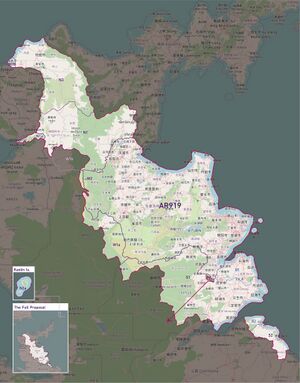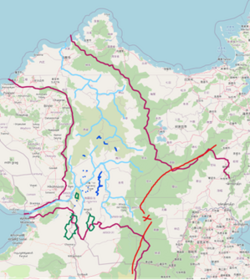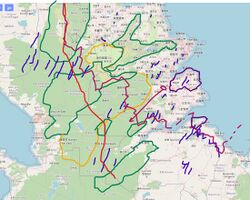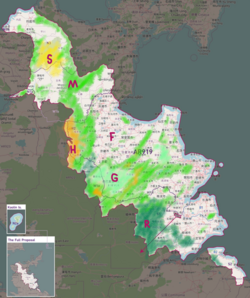Forum:Territory application/AR919 - Application plan for territory expansion of the of The Republic of Huaxia
|
抽象 / Abstract
| 各位OGF的管理员朋友早上/中午/晚上好,不管您所在的国家/地区是否提倡农历新年「中国春节」的概念,我们在此向您问候:「蛇年快乐!」 | Good morning/afternoon/evening to all OGF administrators. Regardless of whether your country or region acknowledges the "Chinese Spring Festival," we extend our greetings to you: "Happy Year of the Snake!" |
本次申请,缘起:
|
The motivation for this application stems from the following:
|
| 为了华夏更好的发展,我们希望适当扩大华夏的领土。 | To facilitate better development of Huaxia, we hope to expand its territory moderately. |
| 根据事前的站内信咨询,我们主要的扩展方向是向南;但是出于「向南太多会导致首都过于偏北」,我们可能也需要适当向北扩展以保持平衡。
在本申请的第一节我们将介绍扩展的范围,并按地块编号,我们尚不确定我们可以扩大多少,以上仅作为我们本次申请最理想的范围;如果管理员认为过大,还请削减部分地块。 下面将简介扩界后华夏的疆界、自然地理、人文社会等本申请所需的基本情况。 |
Based on prior consultations through in-site messages, our primary direction for expansion is southward. However, to avoid the capital becoming excessively northern, we may also need to extend slightly northward.
In the first section of this application, we will introduce the proposed expansion area and provide details by numbered land block. We are uncertain how much expansion could be approved, so the proposed range represents our most ideal expectation. If you, the administrators, find it excessive, please partially reduce some land blocks as necessary. The following sections will outline the expanded borders of Huaxia, its natural geography, human society, and other essential aspects required for this application. |
申请范围 / Proposed Expansion Area
| Territory ID and proposed name | |
|---|---|
| The Territory ID (from OpenGeofiction:Territories, e.g. AR123a) and proposed name of the country |
| AR919 - 华夏共和国 | AR919 - The Republic of Huaxia |
| 计划扩展的区域如下图,包括以下内容: | The planned expansion area is illustrated in the diagram below and includes the following: |
|
|
|
|
|
|
|
|
|
|
| 不过出于我们希望拥有一些各地、各方向的海岸线和一些可以开展边界合作的邻居(即希望有更多的私有区域邻国)的愿景,我们希望不论怎么样可以有N1a、N2a、N2b这几个小地块(接受以飞地形式出现)。 | Due to our vision of having diverse coastlines in various regions and fostering boundary collaboration with neighboring nations (i.e., increasing the number of private neighboring areas), we hope to retain N1a, N2a, and N2b regardless of other adjustments, even if they must exist as exclaves. |
自然地理 / Physical Geography
| Physical geography | |
|---|---|
| An overview of climate, topography and landscape of the country. It is advised to also create a sketch, you can add a link to this (hosted on imgBB, Postimages or similar, but not imgur.com) |
地形 / Terrain
北部 / Northern Expansion Area
北部的地理部分参考百帝国先前的计划,较为简单,如右图:
|
The northern terrain draws inspiration from the Bai Empire's previous plans and is relatively simple, as shown in the diagram:
|
|
| 气象上我们计划西北岸属于亚热带和湿润地区,而堆离原一带不同于华夏现有地区较为湿润的气候,其会更加干燥,考虑一片草原或者荒漠(但不至于或极少是沙漠)。
我们还计划在西北部靠近山区的海岸线按照OGF的《海洋规则》增加一些小的岛屿,具体计划将在申请被同意后编写或直接绘制在图上。 |
Climatically, the northwestern coast is planned to be subtropical and humid, while Duiliyuan will differ from Huaxia's existing humid areas, being drier, possibly resembling grasslands or arid regions (but not deserts).
Additionally, we plan to add small islands along the northwestern coastline near the mountains in accordance with the Rules of the sea of OGF. The details will be drafted or directly drawn on the map after the application is approved. |
南部 / Southern Expansion Area
南部的地形稍复杂一些,在此连同部分周边蓝区一起规划,如右图:
|
The southern terrain is more complex and includes parts of the surrounding blue teritories, as shown in the diagram:
|
|
| 我们还计划在长海(Changhai)—日出岛(Richu Is.)一带中间的海域添加一些小的岛屿,领海可能会封闭,参考中国渤海。 | Also, we plan to add small islands in the waters between Changhai (长海) and Richu Island (日出岛). The territorial waters in this region may be enclosed, drawing inspiration from the Bohai Sea in China. |
地貌 / Landform
未来,华夏片区整个的地面风貌主要分为平原、草地和各种树林等。具体如右图所示,其中:
|
In the future, the terrain across the Huaxia region will be primarily composed of plains, grasslands, and various types of forests, as depicted in the diagram. Specific areas include:
|
人 / Human Geography
 | Human geography |
|---|---|
| A brief description of the territory demographics, economic development, land occupation, infrastructure and mapping style |
经济 / Economy
| 总的来说,扩大后的华夏仍大致遵循我们之前对经济的规划,即华夏的经济发展面临不平衡的问题。沿海和沿繁花江(Fanhua River)一带是经济较为发达的地方,分布有华夏的几个都市圈,人口密集,有较多的新兴产业发展,比较符合当下现实中国的情况;其余地方经济水平一般,仍以农业和工业(尤其是重工业)为主,城市规模均较小(大部分的地级市城区大小仅比现实中国的县的城区稍大),更多参考现实中国在2000年左右的发展水平。 | Overall, the expanded Huaxia region continues to follow the previously proposed economic plan, where economic development faces significant regional disparities. The coastal areas and regions along Fanhua River (繁花江) are economically advanced, hosting Huaxia's main metropolitan areas with high population density and thriving new industries. These regions mirror the current situation in modern China. Other regions have generally lower economic levels, focusing primarily on agriculture and industry (especially heavy industry). Cities are small—most prefecture-level city centers are only slightly larger than county-level centers in early-2000s China. |
| 较先前规划(以大华岭为界,西农业,东工业)不同的是,考虑到人口总量和对粮食的需求,我们计划扩大垦区的规模,东部也将会有农业和林业等产业;但考虑到气象、地形等原因,它们可能不会成为当地的重要经济来源之一。此外,经济发达地区会更多影响经济一般的地区,这是出于政策的,所以从经济发达的城市圈会有更多的放射性交通网络辐射周边地区,而不是先前的「都市圈内交通发达,但跨区域交通需要提升」。 | In contrast to the earlier plan (with agriculture dominant west of the Greater Hua Ridge and industry to the east), the expanded region includes larger cultivation zones to meet population and food demand. The eastern areas will also feature agricultural and forestry industries, though due to geographic and climatic limitations, these industries may not dominate local economies. More, Advanced economic regions will increasingly influence less developed ones through policy-driven integration. Transport networks radiating from urban centers will ensure better inter-regional connections, replacing the earlier model of focusing solely on intra-metropolitan transportation. |
产业 / Industries
北部区域
|
Northern Expansion Area
|
南部区域
|
Southern Expansion Area
|
交通 / Transportation
| 公路
我们计划扩展我们的干线高速路网。一些省、路的省级高速公路规划已经由部分华夏其他成员放出,我们计划在扩区完成后再次像Huaxia_expwy.png一样绘制一个完整的、全国性的高速公路规划示意图。 先前有人提出过高速公路是否过于密集的疑问,因为先前华夏的行政区较小,导致相邻人口聚集点的距离较近,故在一些区域高速路网较密。未来,正如前文提到的华夏经济状况和后文将提到的扩大行政区划面积的方针,我们不会疯狂地修建,甚至可能不会达到现实中中国中等经济水平地区的密度。我们已经确定在经济较为发达的地区,相互平行的高速公路的间距至少在20-30千米以上,其他区域则应该远大于此(参见《绘图指南》)。
(1)将现有的上京(Shangjing)—阳东(Yangdong)高速公路(GJ1 京边高速)从慈阳(Ciyang)以西的东虹(Donghong)附近断开,以北的部分改线,西向北跨过同胞大江(Tongbao River),从通明关穿越中央山脉到达柚国自治区东界附近,再向北沿堆离原中部穿越之,抵达符图(Futu)并向北延伸至海岸,作为西百地区(West Bai Region)的南北干线,并辅以东西向的支线高速; (2)向北沿伸现有的上京—三江(Sanjiang)高速公路(GJ2 京三高速),过河接入现有的百国的高速至边界,作为百南部中央山脉以东的南北干线,并辅以东西向的支线高速。
(3)南延央湖(Yanghu)—石布石(Shybshi)高速公路(GY7 东南沿海高速)经茂桑(Maosang)、梓湘(Zixiang)、文屋(Wenwu)到达自由港(Ziyougang),作为南部的南北干线,辅以连接雀林(Quelin)、又生(Yoso)的支线; (4)从裁雨山(Caiyushan)至自由港沿海设置一条干线高速公路; (5)自林州高原东部的烟狼台(Langyantai)向东经石不石、灵水(Lingshui)、文礼(Wenli)至月湖(Yuehu)设置一条东西向干线高速公路。 未来,连接现有各个主要城市的一般国道也将进一步绘制,但出于复杂度[1]和希望保留的自由度,我们不打算现在提前完全规划,我们将在绘制到一定程度后出图。省道、县道的规划由各省、县的成员负责,故在此不赘述。 |
Highways
We plan to expand our expressway network. Some members of Huaxia have already released provincial expressway plans for certain provinces and routes. Once the expansion is completed, we will create a new, comprehensive national expressway planning map, similar to Huaxia_expwy.png before. Previously, some concerns were raised about whether the density of expressways in Huaxia was too high. This was largely due to the relatively small size of administrative divisions, which resulted in shorter distances between neighboring population centers, leading to a denser highway network in certain areas. In the future, as mentioned earlier regarding Huaxia's economic conditions and the upcoming expansion of administrative divisions, we will not engage in excessive expressway construction. The overall density would not even reach that of mid-level economic regions in real-world China. We have already established rules that in economically developed areas, parallel expressways should be spaced at least 20–30 km apart, while in other regions, the spacing should be significantly greater (refer to the Mapping Guide of Huaxia for details).
(1) extend the Shangjing (上京)-Yangdong (阳东) Expressway (GJ1 Jingbian Expressway, 京边高速) from Ciyang (慈阳) westward, realigning it northward from 东虹 (Donghong), crossing the Tongbao River (同胞大江), passing through the Tongming Pass, and reaching the eastern border of the Kyawal-kaw Autonomous Region. It will then run northward through central Duiliyuan, terminating at Futu (符图) and extending to the northern coast to serve as a major north-south corridor west of the Central Mountain Range in Bai; and build some east-west direction supporting expressways; (2) and extend the Shangjing-Sanjiang (三江) Expressway (GJ2 Jingsan Expressway, 京三高速) northward, connecting with existing highways in Bai, to the northern boarder to serve as a major north-south corridor east of the Central Mountain Range in Bai Nation's southern regions; and build some east-west direction supporting expressways.
(3) extend the Yanghu (央湖)-Shybshi (石布石) Expressway (GY7 Southeast Coastal Expressway, 东南沿海高速) southward through Maosang (茂桑), Zixiang (梓湘), and Wenwu (文屋) to Ziyougang (自由港); (4) add a coastal expressway from Caiyushan (裁雨山) to Ziyougang; (5) and construct an east-west expressway from the eastern Linzhou Highland at Langyantai (烟狼台) through Shybshi, Lingshui (灵水), Wenli (文礼), and Yuehu (月湖). In the future, normal national highways connecting major existing cities will also be further mapped. However, due to the complexity[1] and the flexibility for future mapping, we do not intend to fully plan them in advance. Instead, we will release a map once a significant portion has been drawn. As for provincial and county roads, their planning is the responsibility of respective provincial and county members, so we will not elaborate on them here. |
铁路
总的来说,华夏未来的铁路将会分为6个路局,其中5个从北到南分别是「西百」「江诸」「东原」「天南」「南疆」,剩下一个为专门服务山区的「山区」局。另外,我们未来绘制的铁路设施会尽可能呈现一个从旧到新的过程(比如一些单线的干线铁路设定上修建年代早,所以建设标准较低,在近年复线化后有上下行线路分离、会废弃掉一些过于糟糕的线路等等),以使得绘制更加真实,我们之前很少注意这方面。 |
Railways
Overall, the future railway system of Huaxia will be divided into 6 railway bureaus,five of which from north to south are "Xibai" (西百), "Jiangzhu" (江诸), "Dongyuan" (东原), "Tiannan" (天南), and "Nanjiang" (南疆), and the last one is "Shanqu" (山区) that only severs the mountain area. Additionally, in our future railway mapping, we will strive to depict a transition from old to new infrastructure. For instance, some single-track main lines will be set as having been constructed earlier with lower standards. In recent years, as they double-tracking, they may feature separate tracks for up and down directions, and certain severely outdated lines may be abandoned. This approach aims to enhance the realism of our mapping, an aspect we previously paid little attention to. |
航空
|
Airports
|
水运
|
Water Transport
|
其他 / Others
| 经济有关的未提及的其他方面如教育、体育等未尽事宜,遵从现有华夏的一般性计划,参见我们的合作页面。 | Other aspects related to the economy, such as education and sports, will follow existing Huaxia's general development plans. Further details can be found on Huaxia collaboration page. |
人口 / Population
| 我们先前计划的华夏有5亿人口,但华夏只有1.8倍现实中国四川省的大小(四川省人口密度在中国较高,人口截至2020年末中国第七次全国人口普查为83674866人[2]),无法承载5亿人口,但扩区后的大小承载5亿人则较为合理,故总人口指标不变。扩区前的区域作为核心区计划承载2.3亿人口,南部扩区计划承载1.6亿人口,北部扩区计划承载1.1亿人口,主要分布在前文提到的平原区。 | Previously, we planned for Huaxia to have a population of 500 million. However, as Huaxia was only 1.8 times the size of present-day Sichuan Province in China (which has a relatively high population density, with a population of 83,674,866 according to China's 2020 Seventh National Census[2]), it could not accommodate 500 million people. With the expansion of territory, the total area can now support a population of this scale. Thus, the total population can remains unchanged. The pre-expansion core area is planned to accommodate 230 million people, the southern expansion area 160 million people, and the northern expansion area 110 million people, primarily distributed in the previously mentioned plains regions. |
| 虽然扩区后华夏总的人口密度仍较现实四川省大,但鉴于华夏的城、镇因规模较现实中国更小而分布比现实中国更密集(先前规划「华夏各行政区均是现实中国行政区缩水版」所致),该密度较为合理。人口将会影响城镇大小,结合后文将会提到的「合县并市」计划,我们会适当放宽城市建成区大小的限制。 | Although the total population density of Huaxia after expansion will still exceed that of present-day Sichuan Province, it is reasonable considering that cities and towns in Huaxia are smaller but more densely distributed than in present-day China (due to the earlier plan that "all administrative regions in Huaxia are scaled-down versions of their real-world Chinese counterparts"). This higher density aligns with the unique administrative and urban planning structure of Huaxia. Additionally, population considerations will influence the size of urban areas, and in line with the proposed “county-merging and city-consolidation” plan, we will appropriately relax restrictions on the size of built-up urban areas. |
行政区划 / Administrative Divisions
由于先前华夏大小的限制,华夏目前的县(厅)、市普遍偏小[3],在扩区之后按照现有县市大小继续划界容易出现行政区划数目过多的问题,配合本次扩图,我们计划对现有区划体系做出一定修改:
|
Due to the previous size limitations of Huaxia, counties/sub-prefectures, cities, and other administrative divisions were generally small[3]. After the expansion, if the existing sizes of counties and cities are maintained, it may result in an excessive number of administrative divisions. To address this, adjustments to the current administrative structure are planned:
We have internally developed draft principles and preliminary plans for county-merging and city-consolidation, along with some delineations of provinces, cities, and counties. However, due to space limitations, the details cannot be included here. We appreciate your understanding. |
历史文化 / History and Culture
| History & culture | |
|---|---|
| A brief description of the intended culture and language |
历史 / History
| 历史方面,南部将被设定为古代是华夏的江诸(Jiangzhu)王朝(历代繁花江一带政权,即现实的中原王朝)之势力范围,有数个朝贡国,其中部分被江诸王朝兼并,现在的版图(指区域扩展后的疆域)最早在公元150-180年华夏大一统时形成,后又分分合合,并在约600年前再次统一,此后江诸对南部的统治不断加强,版图趋于稳定。 | In terms of history, the Southern Expansion Area will be set as historically under the influence of the Jiangzhu Dynasty (江诸, referring to successive regimes along the Hua River, equivalent to the Central Plains dynasties in the real world). This region once contained several tributary states, some of which were annexed by the Jiangzhu Dynasty. The current territory (referring to the expanded area) first formed during Huaxia's unification in AD 150–180, experiencing cycles of division and reunification. It was unified again approximately 600 years ago, after which Jiangzhu strengthened its governance over the southern region, leading to stabilized borders. |
| 关于北部,我们在2024年10月闲暇时,根据百帝国在维基页面遗留的一些信息和我们的一些想法,初步讨论出了一个解决二国历史存在问题的方案,详见华夏的维基页面,但当时鉴于Zhenkang的退出,我们无法征求他的意见。在此基础上,我们做出以下延伸:
百帝国因为战后帝国的政治制度和其他问题,逐渐衰落,内部有起义、民心不安,起义军借着堆离原地区少数民族较多,联合了他们,并控制相当多的领土(即我们希望扩展的部分)并与政府谈判,最终达成了和解,起义军控制的领土独立,原东部的政府被改组;独立出的地方因为自然条件较差,也未能取得很好的发展,且南方(即华夏)经历经济挫折后逐渐强盛,最终经过此地区各族人民公投,此地区于数年后加入华夏。 |
For Northern Expansion Area, in October 2024, during leisure discussions, we drafted a preliminary plan to address historical inconsistencies between the Bai Empire and Huaxia, based on leftover information from the Bai Empire's wiki page and some of our ideas. (See the Huaxia Wiki page for details.) At that time, due to Zhenkang's withdrawal, we were unable to consult his opinion. Based on the plan we drafted, we extend the history as follows:
The Bai Empire, due to political and systemic issues following a postwar decline, gradually weakened. Uprisings and civil unrest emerged, with rebels aligning with local minority groups in the Duiliyuan where many minority populations live, ultimately seizing significant territories (the areas we aim to include in the expansion). Negotiations ensued between the rebels and the government, leading to a settlement that granted independence to rebel-controlled lands. The government in the original eastern territory underwent restructuring. However, the newly independent region, hindered by poor natural conditions, failed to achieve substantial development. Meanwhile, the southern region (i.e. Huaxia) grew stronger after overcoming economic setbacks. Eventually, through referendums involving the local populations of various ethnic groups, the region voted to join Huaxia within a few years. |
文化 / Culture
| 文化方面大致遵从我们现有的计划,南部原先与华夏主要的地区间隔了大面积的雨林,分布了数个民族,在华夏形成现在的疆土后,其上的人被华夏主体民族兴族部分同化,吸纳了一些兴族习俗,但也保留自己的传统,此区域的原本的文化不同于目前设定的「以中国北方为主」的文化,会偏中国南方,会参考如湘鄂、闽南、粤广一带的文化,这一带人口主要为汉族但与中国北方文化有一定差异。也可能会融合一些中国西南地区的文化(中国西南有多个少数民族,民族文化亦非常丰富,结合部分西南地区的民族文化可以使得该区域文化更多样以符合设定上此区域多民族的特点,但西南地区的文化会主要应用在北方,详见下文)。 | In terms of culture, the Southern Expansion Area mostly follows the existing plan. Originally, a vast rainforested area separated the southern region from the central regions of the Xia Empire. It was home to several different ethnic groups. After the current borders of the Xia Empire were established, the dominant ethnic group in the empire, the Xing (兴) people, assimilated parts of the local populations. They absorbed some customs of the local people, but the region retained its own traditions. The culture of this region is distinct from the "northern China" culture of the present-day Xia Empire. It is closer to the culture of southern China, referencing areas like Xiang-E (湘鄂), Min-Nan (闽南), and Yue-Guang (粤广). The population is primarily Han, but there are noticeable cultural differences from the northern Han culture. There may also be a blend of Southwestern Chinese ethnic cultures, as Southwestern China is home to many ethnic minorities with rich cultural traditions. This combination of influences reflects the area's diverse ethnic composition. The Southwestern Chinese cultural traits would primarily be applied to the Northern Expansion Area, as explained below. |
| 北部方面,向北扩展的区域中中央山脉以西的地方、和部分向西扩展的地方,因大山阻隔,文化上与江诸地区有差异,结合部分山区的地理,计划主要参考西南地区的文化进行设计,反映到地图上比如可以通过绘制有中国西南特色的山寨、梯田,以及取西南风味的地名等进行呈现,同时,结合AR923的语言,我们认为在北部区域使用西南地区部分的少数民族语言非常合适(中国西南地区有的语言和泰语、缅甸语很相似),我们会考虑使用(我们相信简单的通过词拼凑地名是可以接受的)。
向北扩展的区域中中央山脉以东的地方(即百国的东南部),因地理上的接近,文化则与现有华夏设定一致,不过,考虑到我们历史上设定此区域以前是百管辖,华夏和百分离后(于14世纪初,详见我们的维基),百的文化相较于华夏更受到西方的影响(殖民影响),我们期望为类似于新加坡的文化[4],这可能会反映在城市中老城区用地的风格上,比如可能会有私人住宅,但被设定为回归华夏后新建的市区,尤其是近20-30年建设的区域,仍会是现代中国的风格。 |
In the Northern Expansion Area, the western part of the expanded area beyond the central mountain range and some of the areas extending westward are geographically isolated by large mountain ranges. Therefore, these areas have a distinct cultural identity from the Jiangzhu region. The plan is to draw inspiration from Southwestern Chinese culture, which could be reflected in the design of villages, terraced fields, and place names with a Southwestern flavor. Additionally, based on the AR923 language, we believe it is suitable to use some of the minority languages from Southwestern China in the northern region (some Southwestern languages are similar to Thai and Burmese). We plan to incorporate this by using word combinations for place names.
As for the southeastern part of the northern region (the southeastern part of the Bai Empire), due to its geographical proximity, its culture aligns with the current Huaxia culture. However, considering that this area was once under the control of the Bai Empire (prior to the early 14th century, as detailed on Huaxia Wiki page), the culture here has been more influenced by the West (colonial influences). We envision the culture of this area being similar to that of Singapore (maybe[4]?). This may be reflected in the style of older districts in cities, where private residences might be present, but in newly constructed districts, particularly those built in the past 20-30 years, the style will remain modern, in line with current Chinese trends. |
脚注 / Notefoot
| Past mapping | |
|---|---|
| To support your request provide links to areas of OGF mapping which showcase your mapping skill. Mapping relevant to the requested theme & geography is especially useful. | |
| The {{coord}}, {{node}}, {{relation}} or {{scalehelper}} templates can optionally be used to link to the OGF map - they result in nicely formatted links. Or you can paste in a URL. |
| 下面给出了华夏合作项目参与者的各种过往绘图。 | Below shows some of the most significant past drawings of the participants in the Huaxia collaboration.
(Not all, just what we could come up with first) |
| Username & date | |
|---|---|
| Sign and date the application by typing four tildes (~~~~) without spaces or "nowiki" tags. |
- NM$l (talk) 14:46, 28 January 2025 (UTC)
- 114514aaa (talk) 15:21, 28 January 2025 (UTC)
- 快乐的老鼠宝宝 (talk) 17:57, 28 January 2025 (UTC)
- Taksine (talk) 06:36, 29 January 2025 (UTC)
- Z Empty (talk) 06:43, 29 January 2025 (UTC)
- Yongdinghe (talk) 08:49, 29 January 2025 (UTC)
- ↑ 1.0 1.1 复杂度可参考《国家公路网规划》最后一页。 The complexity could refer to the map on the last page in the National Highway Plan of China.
- ↑ 2.0 2.1 国家统计局, 国务院第七次全国人口普查领导小组办公室. 第七次全国人口普查公报. 2021.
- ↑ 3.0 3.1 现实中国的地级市的辖区面积的中位数约为12000平方千米,而目前华夏的约为3000平方千米。 In reality, the median area of prefecture-level cities in China is about 12,000 square kilometers, compared to about 3,000 square kilometers in Huaxia.
- ↑ 4.0 4.1 打个不严肃、非常局限的比方,如果你玩《崩坏:星穹铁道》这款游戏,那么这两个文化的区别将会是其中仙舟罗浮和仙舟朱明之间的文化差别。A lighthearted and limited analogy: if you have played the game Honkai: Star Rail, the cultural difference between these two areas can be likened to that between Xianzhou Luofu and Xianzhou Zhumin.
 | Discussion |
|---|---|
| Discussion for clarification & decision |
This is an ambitious expansion. As a former mapper and coordinator of Bai, I like the plans they have for former west and southern Bai. I shall wish the Huaxia team all the best in this application. Should the Huaxians also decide to take all of Bai, they are also free to do so, pending admin's approval. There's more demand for mainland-style mapping, so I foresee that Huaxia would need more room that way.
Just an additional request: In Xihan Province there's a nuclear testing base mapped there. I hope it can be kept, but if Huaxia doesn't wish to be a nuclear power, then I shall reclaim it for Kanglapo. 新年蒙恩,金蛇狂舞。--Zhenkang (talk) 00:49, 29 January 2025 (UTC)
- The admins may prefer to let the southern part of Bai marge into Huaxia while the northern part get split into 3 parts as what they said when we consulted before, if they keep their mind.
- We do not know how much we could expand, but taking some parts of Bai is with strong request by many of the collaborators and needs of getting Ciyang's status reasonable. For the nuclear testing base, if it come into Huaxia, we will keep it. --NM$l (talk) 05:55, 29 January 2025 (UTC)
Hi, I plan to approve this extension later today or tomorrow. It will not be exactly as requested, but it is easier to describe once the boundary edits are made. Best wishes for the new year. Thanks/wangi (talk) 14:01, 29 January 2025 (UTC)
 |
Territory application approved |
|---|---|
| Approved. Expansion is generally larger than requested, with all of ex AR926, all of ex AR904, requested areas of AR909 and northern state of AR924 included. However, the requested area in AR900 has not been included. Also please reach out again to user TGSpace, as this area has been included in the enlarged Huaxia. Moving their mapping to AR900 Commonia would be an option for you to consider, however exclaves are not. Given the inactivity of the user it is perhaps moot. Thanks/wangi (talk) 22:25, 29 January 2025 (UTC) | |



